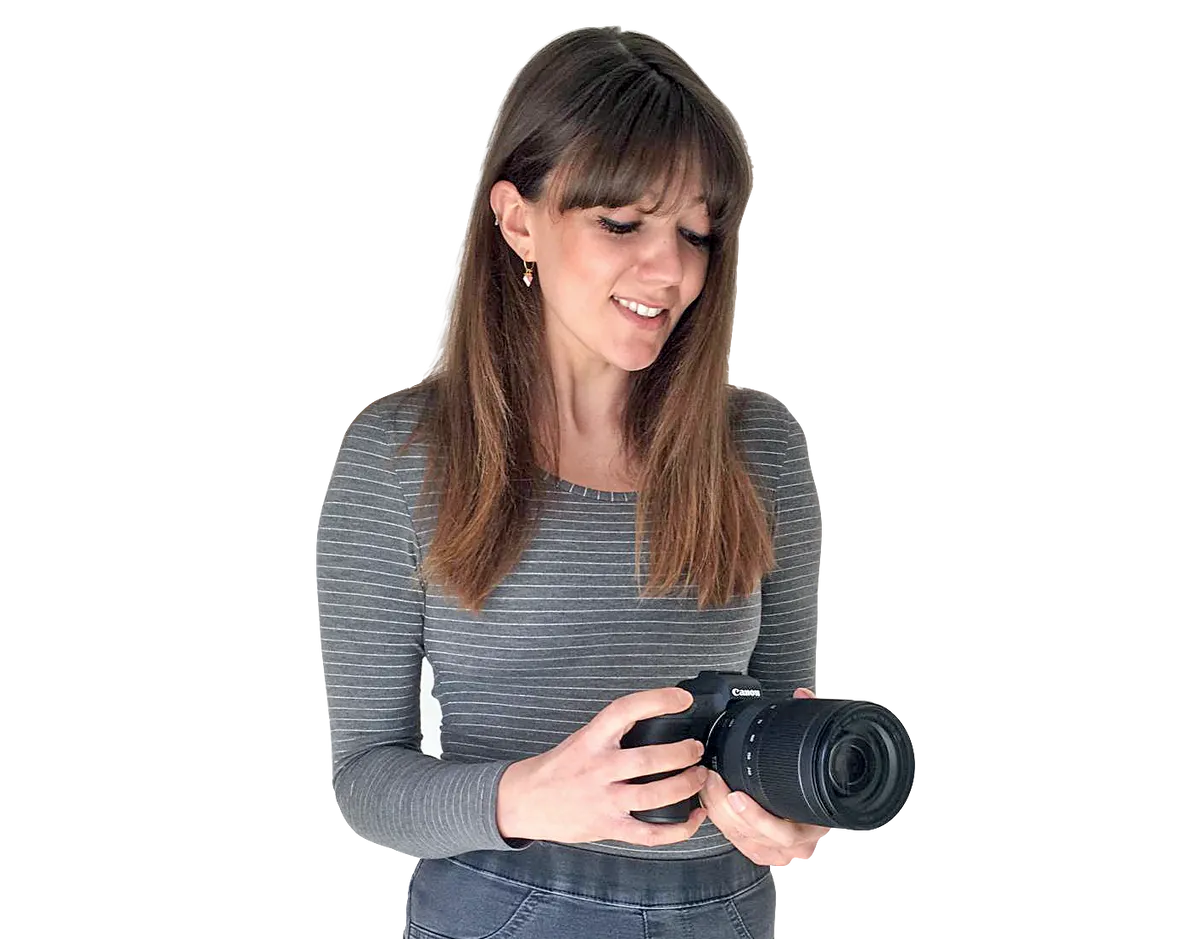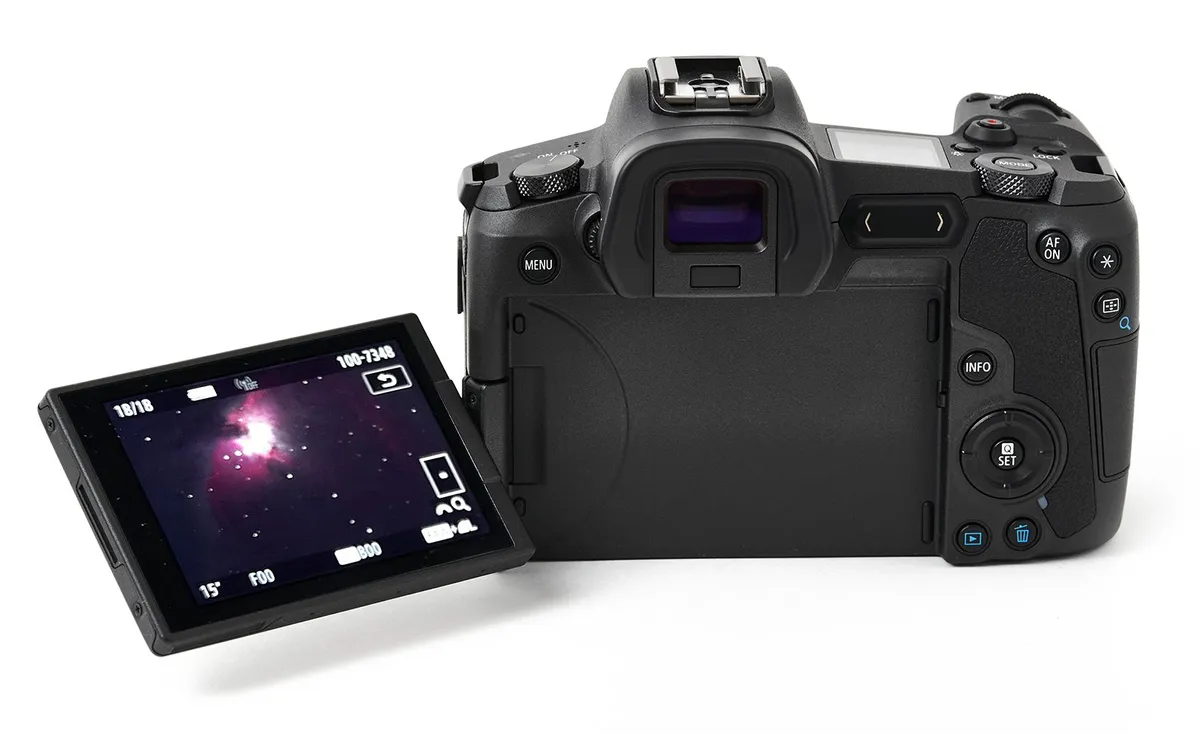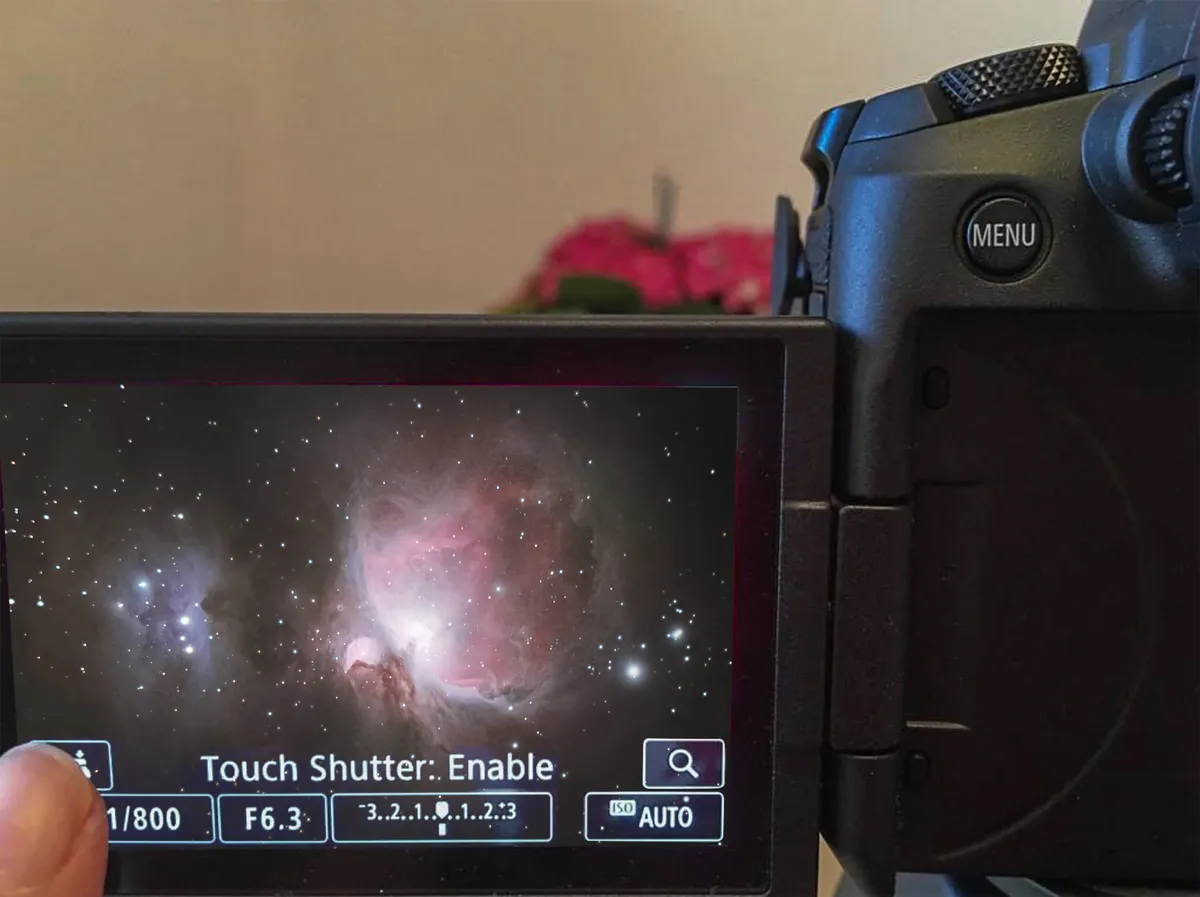The Canon Ra is the first full-frame mirrorless camera from Canon to come ‘astro-adapted’, with enhanced infrared (IR) sensitivity. Although DSLR versions have been released previously, these have been mirrored, with cropped sensors.
The Ra’s 30.3 MP CMOS sensor might not be groundbreaking, but the infrared filter adjustment and full-frame format are big news for astrophotographers.
While the Ra might be lighter than other cameras due to its mirrorless design, it has a solid, reliable feel. It also retains DSLR attributes such as a viewfinder and vari-angle LCD touchscreen.
One of the first things we noticed is that the Ra works in a similar way to a regular Canon DSLR, albeit a high-performing one.
This makes it easy to get to know the camera, both for a novice or an experienced astrophotographer who is used to Canon cameras.
Keep your camera in tiptop condition with our guide How to clean a DSLR camera.
Get the most out of your camera with our DSLR guide.
This camera is on our list of the best cameras for astrophotography.

The camera takes the new RF lenses while EF and EF-S lenses can be attached using the optional extras: including an EF to EOS R adaptor, EF to EOS R adaptor with control ring, or EF to EOS R drop-in filter adaptor. Note that EF-M lenses are not compatible.
Operating the Ra is instinctive; if you’ve ever used a Canon camera before it feels like an old friend.
The standard go-to buttons are where Canon users would expect them, including Live View mode, playback and settings.These are all logically placed for finding in the dark.
Connection to a telescope is achieved using a Canon T-ring and EF to EOS R adaptor, while Bulb mode is accessed in the mode-wheel to enable long exposures.
To focus, we can’t sing the praises of the Ra’s Live View highly enough – using the 30x magnification setting we were able to zoom in and count the four Trapezium stars of the Orion Nebula. This level of detail makes the Ra enjoyable and interesting to use.
Compared to a standard EOS R camera, Canon states that the Ra can detect four times the Ha levels – and we can confirm that it performs as promised.
The Ra’s Wi-Fi and Bluetooth provisions allow you to connect it with a smart device using the downloadable Canon Connect app.
In terms of ports, the Ra comes with the connections you’d expect, including HDMI Out, Microphone In and a remote-control terminal.
If using a telescope, there is an essential setting that allows the shutter to fire when a lens is not attached. This is found in the custom settings menu and is called ‘Enable Release Shutter w/o lens’.
Without this the Ra won’t operate, as it would normally expect to detect a lens.

Meanwhile, for camera and lens photography, the new RF camera lenses have electronic focusers rather than mechanical. On the Canon RF 24-240mm f/4-6.3 IS for example, there is no switch for manual focus.
However, the RF lenses can be set to manual focus from the main camera settings menu.
Canon has added an interesting detail with this, as once in manual mode the 24-240mm displays a distance scale on the Live View screen.
We put the Ra through its paces on several objects with our William Optics Zenithstar 61 refractor, alongside lenses loaned from Canon – the RF 15-35mm f/2.8 L and RF 24-240mm f4-6.3 IS USM.
The Ra’s dexterity shone through while we were imaging a Milky Way panorama.
Imaging with moderate low-level light pollution at 15mm, the Milky Way’s wintertime position was revealed as shallow, but the nebulosity in and around Cygnus was quite visible.
The clever custom white balance allows for daytime photography and while Canon warns that this capability is limited, we were impressed by the Ra’s versatility.
Despite the local light pollution we were surprised at how clean and free of noise (unwanted artefacts) our frames remained.
The Ra comes with a new Raw file format – CR3. This might not sound significant, but as astrophotography software is often built by individuals, it alters the process of image stacking.
At the time of review, stacking software did not recognise CR3 files, but Adobe Photoshop does and this allowed us to convert CR3 to TIFF before stacking.
Due to the detail captured, we discovered the CR3 files are large – our deep-sky sub exposures were between 30MB and 40MB – so you need to ensure your memory card can store a few hours’ worth of data.
Price wise, the Ra comes in at less than Canon’s standard ‘R’ variant, yet we know it’s still a hefty price tag. However, for sheer versatility, ease and pleasure to use, the Ra is well worth the outlay.

The Canon Ra benefits from a modified infrared (IR) filter, allowing it greater sensitivity for detecting delicate nebulosity over non-modified full-frame or cropped sensor DSLRs.
While standard DSLRs register light up to a wavelength of 650 nanometres due to an IR-cut filter, astrophotography cameras need to go further for optimal performance, especially on nebulae.
Hydrogen, the primary gas in emission nebulae, emits hydrogen-alpha (Ha) light at around 656nm, so we need our camera sensors to detect a few extra nanometres.
Compared to a standard EOS R camera, Canon states that the Ra can detect four times the Ha levels – and we can confirm that it performs as promised.
As seasoned DSLR users, we know what to expect of winter targets such as Orion from our own equipment and after only an hour’s imaging with the Ra we were impressed by the depth and detail from both the Running Man and Orion nebulae.
The clever custom white balance allows for daytime photography and while Canon warns that this capability is limited, we were impressed by the Ra’s versatility.

Mirrorless
This feature offers key advantages over traditional DSLR astrophotography. Not only is it lighter, but mirrorless cameras allow for faster imaging with no delay for ‘mirror flip’ and reduced vibrations as the shutter fires. When setting up a shot, the smooth imaging style enhanced our routine.
Full-frame
The Canon Ra’s 30MP full-frame sensor improves low light performance and image noise (unwanted artefacts) at a high ISO. At 36mm x 24mm it’s physically larger than most designated astro-camera and DSLR sensors and offers a wider field of view over APS-C cropped variants. Furthermore, a full-frame sensor offers an improvement in overall image quality and a higher dynamic range.
Live View
The Canon Ra’s Live View function is outstanding for many reasons, but not least because of its clarity and sensitivity in low light. We were able to clearly see nebulae and galaxies via Live View without the need to take an image, saving us time when locating and positioning objects in frame.
Magnification
If the Live View wasn’t impressive enough, the 30x magnification overhauls focusing precision. We found it easy to locate a star and reduce its circumference to a pinpoint, with no noise disrupting the process. The 180% zoom capability was also useful for inspecting frames afterwards to check tracking accuracy.
Touch-screen sensitivity
When touch-screen imaging is enabled, we were amazed at how lightly we needed to touch the LCD screen to take a shot – a light tap rather than a firm prod. There was no risk of nudging the camera to take an exposure, or while changing ISO and exposure settings.
Vital stats
- Price £2,599.99 (body only)
- Sensor 36 x 24mm 30.3MP CMOS sensor
- ISO range 100-40,000
- Live View magnify image 5x, 10x or 30x for manual focusing
- Size 135.8 x 98.3 x 84.8mm
- Weight 580g (660g with battery and memory card)
- Supplier Canon
- Tel +44 (0)207 660 0186
- store.canon.co.uk
This review originally appeared in the June 2020 issue of BBC Sky at Night Magazine.
